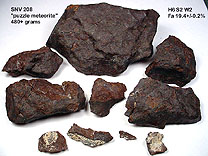
An Article In Meteorite-Times Magazine
by Robert Verish
Reconstructing Fragmented Meteorite Finds
This month's "Bob's Findings" article reports on the on-going efforts to piece back together some recent meteorite finds that have been badly fragmented and/or transported. As if just trying to find all of the fragments isn't enough of a chore, trying to reconstruct the original pre-weathered masses is like trying to solve a 3-D puzzle.
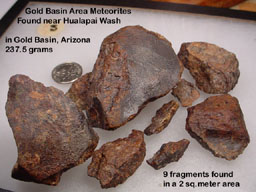
|
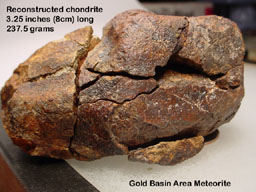
|
|
Gold Basin Area meteorite puzzle - PIECES
|
RECONSTRUCTED Gold Basin Area meteorite
|
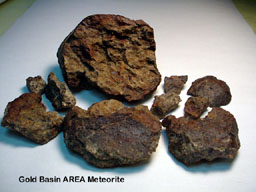
|
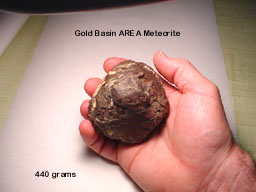
|
|
Gold Basin Area meteorite puzzle - PIECES
|
RECONSTRUCTED Gold Basin Area meteorite
|
A type of "reconstructed meteorite" that may be more familier are the so-called, "puzzle" meteorites from the Gold Basin Area of Arizona. Since these meteorites fell over 15,000 years ago, there has been ample time for the individual stones to weather, fragment, and move apart from each other. This "moving apart" is a natural geologic process termed, transportation. Fragments are transported "down hill" by gravity, whether the medium is water, wind, or bioturbation. In the Gold Basin area, fragments are rarely transported farther than several meters. The majority of these "puzzle" meteorites are found having fragmented in-situ, lending evidence that this fragmenting process occurrs after whole stones survive falling and land intact.
But even if an individual stone is lucky enough to survive landing intact on a dry lake bed, evidence is mounting that shows meteorites weather and fragment faster on a dry lake, and that these fragments are transported from each other faster and farther apart. This is why it takes a great deal more effort to reconstruct a fragmented meteorite from a dry lake. In variably, there is always some percentage of the original stone that remains unaccounted.
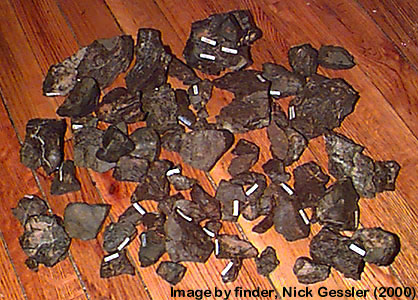
|
|
Nick Gessler's collection of his Primm finds
|
One of my first experiences with reconstructing stone meteorites was with Nick Gessler's efforts at piecing back together some more than 100 meteorite fragments that he and his family had recovered from the Primm strewn field over a period of time from 1997 to 1999. Nick had partial success with several stones, but most of the remaining fragments would not interlock. Although Nick's efforts would bring a smile to his colleagues at UCLA, this exercise brought to light the numerous fragments that were unaccounted for, and an estimate of the missing mass could be made from all of the "partial" stones. This prediction has been bourne out as numerous fragments continue to be found to this day.
Following in Nick's footsteps (literally, his tire-tracks), I took up the search on another Nevada dry lake with the contradictory name, Mud Dry Lake. My first trip there yielded no finds, and I started to think that my predecessors were correct in their negative evaluation of this lake. But I was intrigued by the numerous "sliding rocks" that I had encountered, so I made plans to revisit this area. The following images are from those subsequent trips.
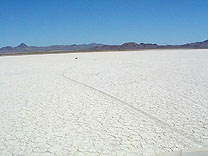
|

|
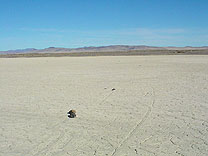
|
|
How do rocks get transported?
|
Clocked this one at 1.2km/year!
|
Just follow the rocks! (to the meteorite;-)
|
The images above depict various basaltic rocks that have "migrated" over the lakebed surface leaving behind a track which essentially records their latest movement. Researchers disagree whether ice-rafting is a major contributor to this "movement", but all agree that wind is the driving force. A curious thing that I noticed about these tracks were that they traveled against the prevailing wind direction for that area. Abandoning my preconception to search for meteorites by following the direction of the prevailing wind, I started to follow the tracks of the migrating rocks across the lake. The tracks led me to a shoreline. Lo and behold, I finally made a find! It was the first fragment found (of what were to be many more) of the Mud Dry Lake meteorite.
Just for clarification: All of the following meteorites that are discussed below, were for the most part INTACT after they landed. All of them fragmented post-impact from weathering. While weathering, these fragments were subsequently transported away some unknown distance from the spot where the originally intact stone landed. Also, the author is the finder of the Mud Dry Lake (prov.) meteorite, as well as the other name-pending-approval meteorites discussed in this article.
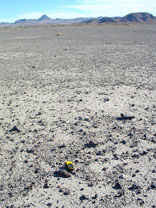
|
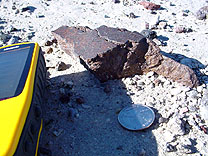
|
|
The first fragments of Mud Dry lake are found!
|
Clearly, this fragment came from a much larger mass.
|
So often, during the many hours of searching for a meteorite, a person starts to doubt their visual acuity, and wonders whether finds are being missed among the many rocks that are being walked over. But then, just when you are about to give up, you walk right up onto a find, and it is so obviously a meteorite that you wonder why you ever had any doubts! As is more often the case, I spotted this fragment from ~15 meters away.
I took GPS coordinates and documented this find, and more importantly, the surface it was found upon. My partners were on the other side of the valley, and I tried to radio them to get them to come to this find site, but they were out of range. So I made a bee-line to their location. While on my way there, I came upon a pile of rocks that, at first, appeared to be an old firepit. As a rule, I always inspect the rocks that circle these old campfire pits. Well, this time it finally paid off. I stood there in disbelief as I stared down at a boulder-sized meteorite sitting among the other boulders of basalt. After an indeterminate length of time, I finally knealt down and examined the boulder to convince myself that it was paired to my earlier find. I was quickly convinced. It was paired. It was at this point that I realized that there were various sizes of meteorite fragments scattered all around. It was as if an outer shell of the boulder had explosively spalled-off. I quickly recorded the location with GPS, and took off to get my partners. Someone else, other than myself, had to see this. I left behind the boulder, still untouched.
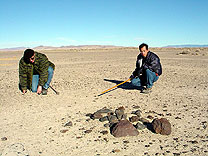
|
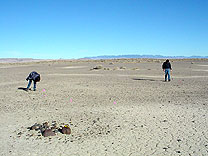
|
|
The large rock on the right is the main mass of the Mud Dry Lake meteorite.
|
Other fragments were scattered about.
|
My partners on this day were Meteorite-Recovery Team members Jerry LaBarbera and his son, James. I had no trouble getting them to go to the find sites. They didn't understand why I didn't have the finds with me, but all I said was that I wanted them to witness the find location as I had found it. When we got back to the "boulder" site they understood completely. Surprisingly, very little was said. It was as if it were a very solomn affair. As if, out of respect for this extra-terrestrial traveler, we delayed approaching it, and instead circled around the site pointing at all the numerous fragments. Marker flags were placed for the farthest fragment in each cardinal point.
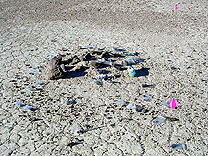
|
|
How did this pile of rocks get here?
|
Reognizing the importance of recording each of the fragments in order to facilitate the reconstruction of the original stone, each fragment was bag & tagged and placed back on the ground before being grouped and placed into larger bags. It was during this process that we noticed there was much evidence of target shooting having occurred at this site, and that there was no evidence that this pile of rocks had ever ringed a campfire. It was becoming more and more evident that this pile of "rocks" had been used to hold targets for target shooting. It helped explain the fragmented condition of the main mass. In fact, there were percussion-mark-like indentations on the one side of the main mass that retained a relict fusion crust. It broke my heart to admit it, but this once-beautiful mass of a meteorite had been blasted away by target shooters!!
If only I could have been there a few years (decades?) sooner!
We could have picked up all of the meteorite fragments in a matter of minutes, but the importance of this find and the find locality required a more conscientious method of retrival. The recovery of all of these fragments at this site took most of the day.
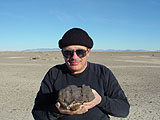
|
|
Click on this image in order to see a CLOSE-UP.
|
Finally, Jerry LaBarbera gets to hold the main mass of the Mud Dry Lake meteorite.
A close look at the surface of the stone that Jerry is holding in the above image, shows the peculiar percussion-mark-shaped features along with the large "thumb-prints" or regmaglypts.
Jerry comments on how heavy this stone is. He thinks that the original stone when it was whole would have been extremely difficult to carry for any distance. Which raises the question - exactly how far was this meteorite transported by the target shooters? Other questions? Did all the other fragments migrate from this "target shooting" site, or did they all migrate from the spot where the original mass impacted? Yet still more questions...
More fragments need to be found in order to answer these questions.
The father and son Meteorite-Recovery Team members, Jerry and Jimmy LaBarbera, have assisted in other group efforts and now have other Nevada meteorite finds to their credit.
They are finders of record in the Meteoritical Bulletin. James has acquired a reputation from his knack of finding subgram-sized whole meteorites and fragments. This keen eyesight has served him well in another fashion. He has a very good eye (and the patience) to visualize how these puzzle pieces can interlock.
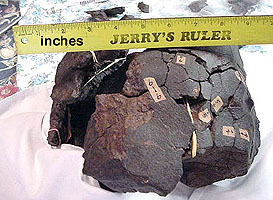
|
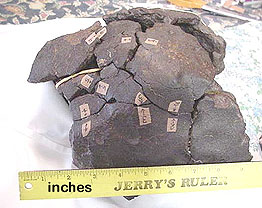
|
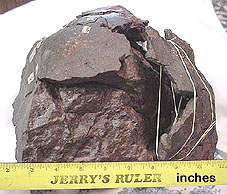
|
|
Reconstructing Mud Dry Lake (L4 [sic H3.8])-
|
On-going effort by Meteorite-Recovery Team.
|
Images courtesy of Jerry LaBarbera
|
Exterior pieces (fragments with portions of the relict fusion crust) are greatly desired in order to complete this reconstruction effort. This effort is still on-going, but at the present, the TKW for MudDL is ~18.2kg.
Most of the "interior" pieces are too badly weathered and may never be able to be utilized. These are the pieces that we utilize for making thin sections.
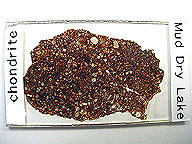
|
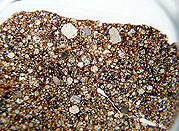
|
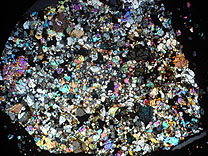
|
|
Thin-sections are available for study -
|
Close-up of thin-section
|
Angular clast in the matrix of Mud Dry Lake (L4) [sic H3.8]
|
Can you fault me for cutting this meteorite and making thin-sections? This meteorite in thin-section looks like the L-version [sic] of the Cole Creek meteorite. [ERRATUM: And no wonder it looks like a H chondrite, because it is! It turns out that the preliminary classification of "L4" was wrong. Mud Dry Lake's classification was finally revealed - after this article was published - as being H3.8 S1 W3 Fa18.2% ]
Mud Dry Lake has been described as being "Wall-to-wall with chondrules"!
Now, moving on to another Nevada meteorite locality...
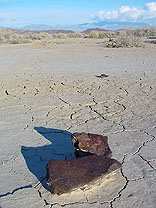
|
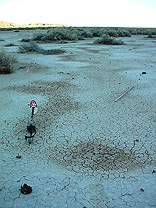
|
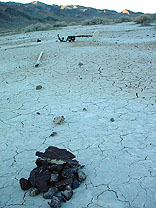
|
|
Nevada meteorite fragments in-situ.
|
RECOVERY of fragmented Nevada meteorite.
|
Piles of meteorite fragments by grid area
|
It never fails. You hunt all day long, and as the sun is setting and you're working your way back to the vehicle, you stumble upon a CLUSTER of meteorite fragments. With what little daylight is remaining, you hustle to try and recover as many fragments as possible. You can only cover so much area, but you hope that you have acertained the lateral extent of these dispersed fragments. (Many months later, we are still finding fragments from this "cluster".) There is the impression that this is actually a mega-cluster of several smaller, overlapping mini-clusters. So I make the decision to make a pile with the fragments from each "mini-cluster". Along with the larger fragments, each pile gets bag & tagged (along with GPS coords) with the hope that enough fragments have been recovered in order to reconstruct the original stone.
But, as you can see from the images below, the "original stone" was much more massive than was anticipated.
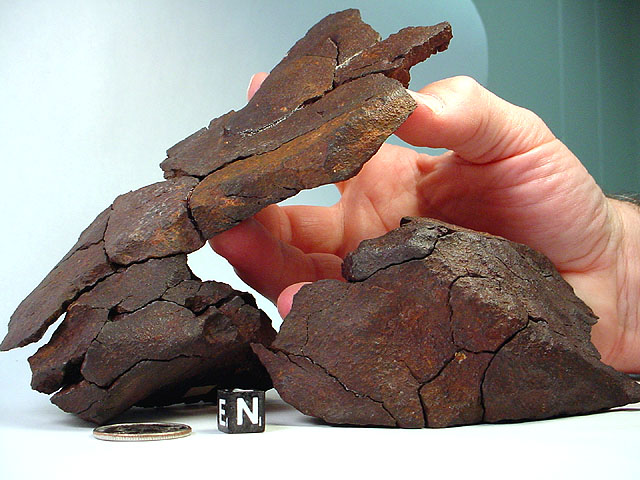
|
|
Image of a new Nevada meteorite in the process of being RECONSTRUCTED
|
The "reconstruction" of this meteorite (pictured above AND below) is another James LaBarbera effort. Bringing these bags of fragments that I found to James was the best thing that I could have done. (My only real contribution to this reconstruction effort;-) Somehow James found the time and a way to connect these pieces. Prior to this reconstruction, none of us had any notion that all of these fragments were part of only one, singularly large individual. Even with some key pieces still missing (which would have allowed all the other pieces to fit into this puzzle), we are still able to estimate the mass of the original stone (~3.5kg). Now we have a new view of the other member fragments of this strewn field. This has given us a whole new understanding of the dispersion elipse and its trend. But there is much more work that needs to be done.
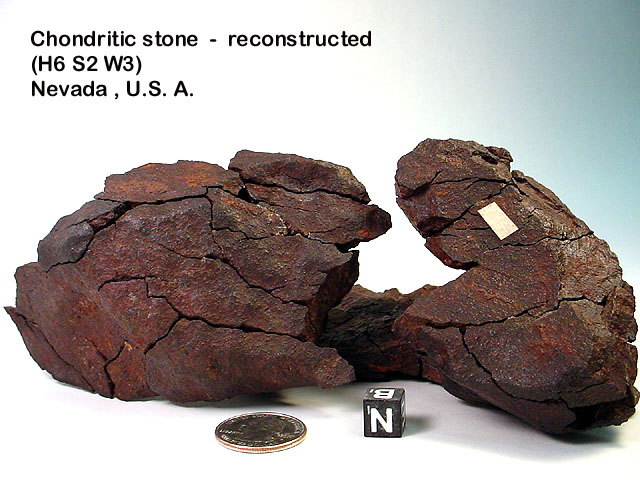
|
|
Another image of the same RECONSTRUCTED Nevada meteorite
|
Questions relating to, how did these fragments accumlate into this cluster, and how were they transported, are still needing to be answered. Until then, the question of where are the remaining fragments, will have to wait to be answered.
Meanwhile, the recovery effort continues. With each newly recovered fragment, we get closer to an answer to these questions. The reasons for maintaining the integruity of this study area are obvious.
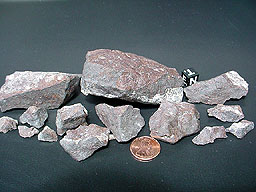
|
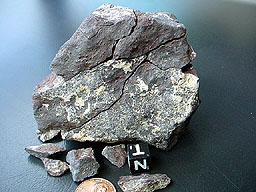
|
|
Nevada meteorite puzzle - PIECES
|
Another RECONSTRUCTED Nevada meteorite
|
To end on a promising note: Elsewhere in this strewn field, some of the stones from this same fall have been more successful at being reconstructed. (See above.)
The topic of my next few articles will continue a series on California and Nevada Meteorites.
My other articles can be found *HERE*
For for more information, please contact me by email:
Bolide*Chaser

![]()



























